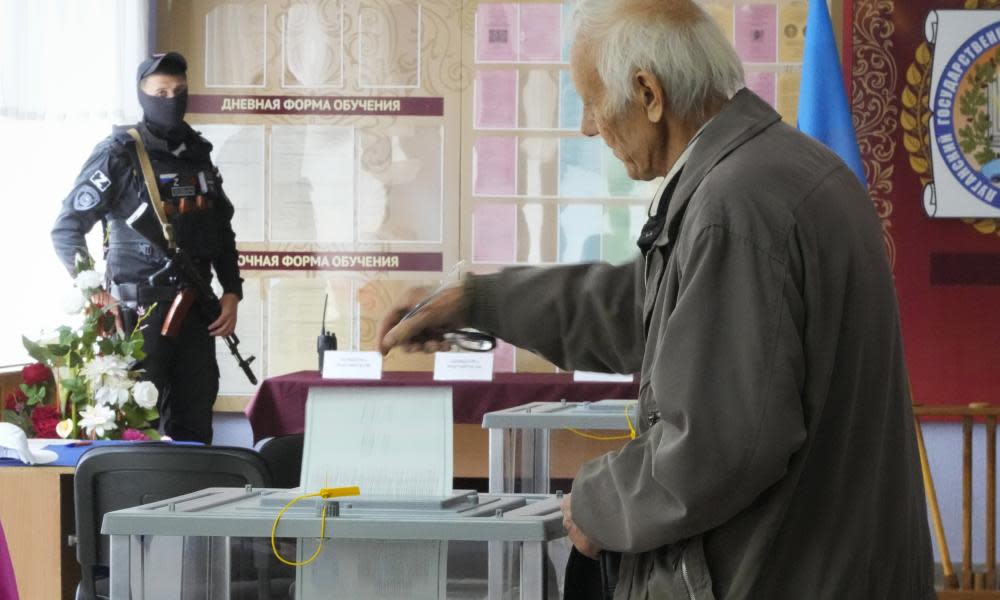Will Russia annex the occupied Ukrainian territories this week?

Russia has finished holding “referendums” in occupied Ukraine, paving the way for an annexation of more sovereign Ukrainian territory in what some have called an “all-in” moment for Moscow. The Kremlin has threatened to annex those territories as early as this week, as Moscow tries to blackmail Ukraine to halt its successful counteroffensive. But with Kyiv – backed by the west – determined to call Putin’s bluff, how could this all play out?
What is happening in occupied Ukraine?
Russia concluded holding a fake “referendum” on the occupied territories of Ukraine in four regions: Donetsk, Luhansk, Kherson, and Zaporizhzhia in which they demanded voters request accession into the Russian Federation. Armed Russian soldiers oversaw the votes in the occupied Ukrainian territories, where many people who support the Ukrainian government have fled Russian control. Ukrainians have descried it as a vote held at gunpoint.
As expected, Moscow got the “results” it wanted. With a rubber-stamped (and universally unrecognised) request for accession in hand, the Russian government is now poised to annex the four territories, which include some land that is not currently under Russian control.
Why is Putin doing this?
In recent weeks, Russia has been losing ground on the battlefield. A Ukrainian counterattack that began last month had captured more than 3,000 sq miles in a matter of just weeks. His troops had been driven out of much of the Kharkiv region, where they’d promised locals that “Russia had come for ever,” and have begun losing territories in Donetsk and Luhansk that they’d held since before 24 February. Moscow was humiliated.
Analysts say that Russia is carrying out these annexations now in order to halt their retreat. By declaring these territories to be part of Russia, Moscow is threatening an overwhelming response, including a possible nuclear attack, as a part of a defensive war unless Ukraine halts its successful efforts to liberate its own territories. By threatening a massive escalation, Russia is seeking to slow its losses until its forces can regroup.
What is the timeline for the Russian annexation?
Many expected Putin to address the Federation Council on Friday, 30 September, with a decision to formally annex the territories. By law, those treaties must first be presented to the Federation Council, the upper body of Russia’s parliament, and then to Putin for a signature.
That could be organised in short order. But now the Federation Council has indicated that it won’t hold a special session on Friday. If that’s true, then the next planned session would take place on 4 October, which is next Friday.
That may indicate that Russia is taking a pause to dangle negotiations with Kyiv and the west in order to slow down Ukraine’s advance. Or that it is testing local support for an annexation. But with little trust in the Russian president abroad, a deal seems unlikely and annexation appears the most likely outcome.
What may happen after annexation?
That’s the main question. Putin and other top officials have suggested that they will begin to treat attacks on the annexed regions as ones on sovereign Russian territory. Ukraine has already made strikes inside Russia during the war, including devastating attacks on a Russian airbase in Crimea. Nonetheless, Moscow is saying now it is serious and is threatening an escalation.
In terms of military operations, Russia may begin targeting more population centres and government buildings with its remaining missiles, similar to the strikes that targeted Ukrainian energy infrastructure near Kharkiv earlier this month.
Moscow could also, possibly, begin holding nuclear drills or even carry out tactical nuclear strikes in order to scare the west. It will also rush mobilised men to the front to hold the lines and prevent Russia from losing any more territory to the Ukrainian counteroffensive.
At home, Russia may close the borders or introduce martial law in certain territories. Measures stipulated by martial law could include seizing property, instituting curfews, arresting government critics, internment camps for foreign citizens, and other severe measures that would further make life in Russia reflect that of a totalitarian state.
What is the western response?
Ukraine has said that it won’t accept Russia’s nuclear blackmail and is intent on liberating all the territory that has been occupied by Russia since the beginning of the war. Western officials have agreed, saying they’ve made very stern warnings to the Kremlin not to escalate this conflict through the use of powerful weapons, including a nuclear option.
That provides for incredible uncertainty in the coming days. Putin, when delivering his threat, said directly that “this is not a bluff.” It may be a bluff but the Russian president will be under heavy pressure in order to hold on to the territory he has taken.
What is the endgame?
In the long term, Putin seems to have the same goal: political control of Ukraine. While before the war he said that he wanted security guarantees about no Nato expansion, it is now clear that he seeks regime change in Kyiv and domination of the country’s political future.
The annexation of territory in east Ukraine will probably not satisfy him. While he wants to halt the Ukrainian advance in the short term and give his troops time to regroup, many expect that he will want to return to the offensive as soon as his troops are ready.

 Yahoo Movies
Yahoo Movies 
